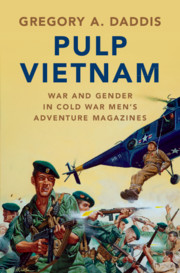Book contents
- Pulp Vietnam
- Military, War, and Society in Modern American History
- Pulp Vietnam
- Copyright page
- Dedication
- Contents
- Acknowledgments
- Introduction: Warrior Heroes and Sexual Conquerors
- Chapter 1 Macho Pulp and the American Cold War Man
- Chapter 2 My Father’s War: The Allure of World War II and Korea
- Chapter 3 The Imagined “Savage” Woman
- Chapter 4 The Vietnamese Reality
- Chapter 5 War and Sexual Violence Come to Vietnam
- Conclusion: Male Veterans Remember Their War
- Notes
- Index
- Plate Section (PDF Only)
Conclusion: Male Veterans Remember Their War
Published online by Cambridge University Press: 22 October 2020
- Pulp Vietnam
- Military, War, and Society in Modern American History
- Pulp Vietnam
- Copyright page
- Dedication
- Contents
- Acknowledgments
- Introduction: Warrior Heroes and Sexual Conquerors
- Chapter 1 Macho Pulp and the American Cold War Man
- Chapter 2 My Father’s War: The Allure of World War II and Korea
- Chapter 3 The Imagined “Savage” Woman
- Chapter 4 The Vietnamese Reality
- Chapter 5 War and Sexual Violence Come to Vietnam
- Conclusion: Male Veterans Remember Their War
- Notes
- Index
- Plate Section (PDF Only)
Summary
Men’s adventure magazines faded in popularity by the opening of the 1970s, the same time as the American war in Vietnam was drawing to its conclusion. Popular media stories of returning veterans hardly lived up to the ideals portrayed in the magazines. Unlike World War II, the war in Vietnam could not be looked back upon nostalgically. Boys had come back not as victorious heroes but as men broken by war. While this storyline was equally fraught with imprecision, it nonetheless challenged the dominant narratives of adventure magazines. Thus, we should ask why a society desires to remember war and male veterans in certain ways. Many veterans’ memoirs, in fact, reflected key aspects of the prevailing narratives within adventure magazines, even as they contested the idea that war was ennobling. How we talk about wartime expectations on heroism, violence, and sex matters. Men’s magazines contributed to a normalization process of sorts, helping tropes about masculinity and gender become embedded into the larger popular culture of the Cold War era. And in times of war – and, arguably, peace as well – this is can be dangerous. War erodes the veneer of civilization that makes behaviors in fantasyland seem more possible and, thus, acceptable.
- Type
- Chapter
- Information
- Pulp VietnamWar and Gender in Cold War Men's Adventure Magazines, pp. 218 - 238Publisher: Cambridge University PressPrint publication year: 2020



